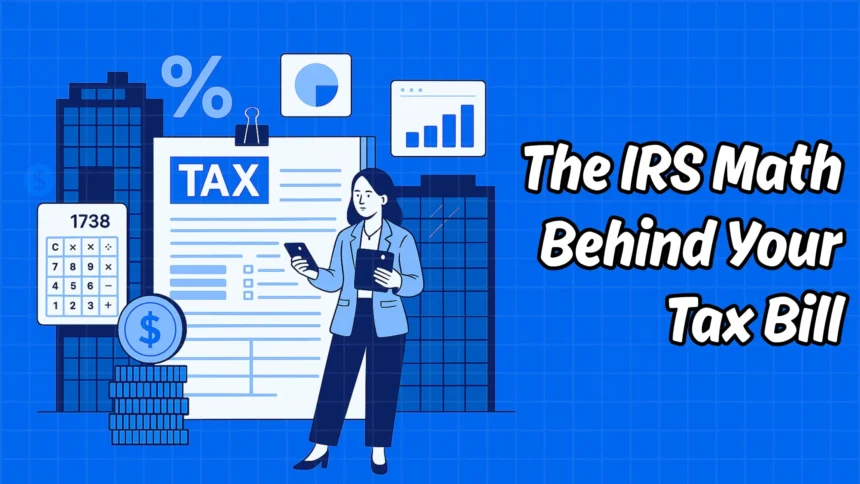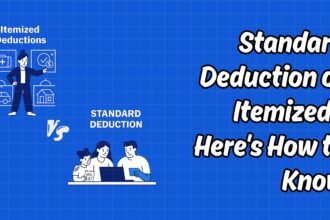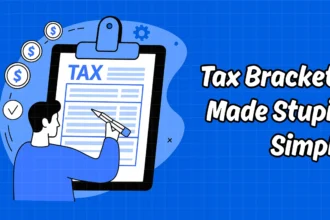Key Takeaways
- The IRS starts with your total income, then subtracts deductions to arrive at your taxable income.
- Your income is divided into tax brackets, with each portion taxed at its specific rate.
- Deductions lower your taxable income, while tax credits cut your owed amount directly.
- Employer withholding or estimated payments are factored in before the final tally.
- The remaining balance is either what you owe or what you’re refunded.
- Learning this process helps you avoid surprises and make smarter choices all year.
Introduction
Ever wonder how the IRS lands on that final number on your tax return? It’s not random—and it isn’t based only on your total income. The formula is logical once you dig into it. In this article, we break down how does the IRS calculate tax step by step, in plain English. By walking through the process for 2025, you’ll understand why you might get a refund—or owe money—without needing a finance degree. Let’s demystify the math.
Step 1 – Add Up All Your Gross Income
The tax calculation starts with your gross income—everything you earned before taxes. This includes wages, freelance pay, tips, interest, dividends, rental income, and any other taxable earnings. Think of all your W-2s, 1099s, and bank statements lining up to show your total earnings.
Some income, though, isn’t taxable. For example, some Social Security benefits, municipal bond interest, and employer-provided health insurance usually get excluded. That distinction matters because this is the baseline the IRS uses.
Your goal in this step is to gather all these income sources and verify them against official forms. If you earned $50,000 in wages, $3,000 in freelance income, and $1,500 in interest, your gross income would be $54,500. That number becomes the foundation of everything—before deductions, credits, and bracket math
Step 2 – Subtract Adjustments to Get Adjusted Gross Income (AGI)
After tallying up your total earnings (gross income), the next step is finding your Adjusted Gross Income—or AGI. Think of it as your income after a few allowed deductions, before taking the larger standard or itemized deduction.
For 2025, common adjustments include contributions to Health Savings Accounts (HSAs), traditional IRA deposits, student loan interest, and self-employment taxes (irs.gov). These things directly lower your taxable base. For instance, if you earned $60,000, contributed $3,600 to an IRA, and paid $1,000 in student loan interest, your AGI becomes $55,400.
Why does it matter? AGI affects everything else. Many credits and deductions have income limits based on your AGI. So reducing it not only lowers your tax bill—sometimes it unlocks better tax benefits down the line.
AGI is reported on Line 11 of your Form 1040. It gives you a snapshot of the income the IRS will use to assess eligibility for various credits, deductions, even retirement contribution limits.
Step 3 – Choose Between Standard or Itemized Deductions
Once you’ve calculated your AGI, you’ll pick between the standard deduction or itemizing to calculate your taxable income.
For 2025, the standard deduction is $15,000 for single filers, $30,000 for married couples filing jointly, and $22,500 for heads of household (irs.gov). Nearly 90 percent of filers choose it because it’s easy—and powerful enough.
But if you incurred big deductible expenses like mortgage interest, large medical costs, or significant charitable donations, itemizing might benefit you. You’ll list each expense individually, and if it surpasses the standard deduction, your taxable income drops even more.
Here’s a simple comparison: say your AGI is $70,000. With the standard deduction, taxable income is $55,000. But if you add up $18,000 in itemized deductions, taxable income drops to $52,000—saving more on tax.
The right choice depends on the math—standard or itemized. Either way, this step significantly affects the tax you owe.
Step 4 – Apply Tax Brackets to Your Taxable Income
Now we get into the core math: applying tax brackets to your taxable income.
Once your taxable income is set (after deductions), the IRS breaks it into chunks taxed at different rates. For 2025, the brackets are 10%, 12%, 22%, 24%, 32%, 35%, and 37%.
Imagine you’re single and end up with $70,000 in taxable income:
- 10% on the first $11,925
- 12% on income from $11,926 to $48,475
- 22% on the remaining $21,525
You’re not paying 22% on the full $70,000—only on the money in the top bracket. That’s why your effective tax rate is much lower than your top marginal rate. It keeps taxes fair and progressive.
This step reveals your base tax—the amount owed before applying any credits or subtracting what you’ve already paid. It’s the most critical part of the IRS formula, and once you see it broken down, it all makes more sense.
Step 5 – Subtract Any Tax Credits (~200–220 words)
After calculating your base tax using the bracket math, it’s time for the real game-changer: tax credits. These are powerful—they subtract directly from what you owe.
Some credits are nonrefundable, meaning they can reduce your tax bill to zero but no further. Others are refundable, which means you could actually get money back.
Here are a few 2025 favorites:
- Child Tax Credit: Up to $2,000 per qualifying kid. It phases out at higher incomes, but leaves real money in your refund.
- Earned Income Tax Credit (EITC): Great for working households—it can send a refund even if your tax bill hits zero.
- Education Credits: Like the American Opportunity Credit—up to $2,500 for qualifying college expenses.
Imagine this: you calculated $4,000 in tax. But between the $2,000 Child Tax Credit and a $1,500 education credit, that drops to just $500 owed. That’s why credits often matter more than deductions.
In short: once you have your base tax from brackets, subtract those credits—it frees up cash or boosts your refund instantly.
Step 6 – Subtract What You’ve Already Paid
The IRS isn’t starting from scratch—they factor in what you’ve paid through withholding or estimated payments throughout the year.
If your employer withheld $3,200 in tax and your bracket calculation says you owe $3,500, you’ll owe an extra $300 come filing—plus possible penalties if you didn’t pay enough through the year (irs.gov).
And for self-employed folks or gig economy earners, IRS rules say if you expect to owe $1,000 or more, you should pay estimated quarterly taxes using Form 1040-ES. Mess that up, and you could be hit with underpayment penalties.
On the flip side, if your employer withheld $4,000 and your total tax bill is $3,500 after credits, you’ll get a $500 refund. It’s always satisfying to see—but remember, over-withholding means giving the government your money interest-free.
Bottom line: compare what you’ve paid so far against your total tax. You’ll discover right away whether you owe more or are due a refund—and it’s all tracked before April filing
Bottom Line – The IRS Isn’t Guessing
The IRS doesn’t pull your tax bill out of thin air. They follow a clear formula: add up your gross income, subtract adjustments to get AGI, pick deductions, apply tax brackets, subtract credits, then offset with payments already made. What remains is your refund or balance due.
Knowing how does the IRS calculate tax gives you more control. You can adjust your withholding, plan contributions, or choose credits strategically—all to minimize what you owe or maximize your refund.
It doesn’t take a CPA—just a willingness to follow the steps. Once you see the logic, tax season becomes less stressful and more rewarding.








